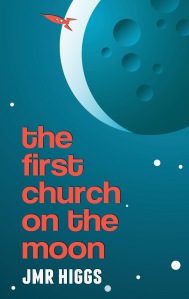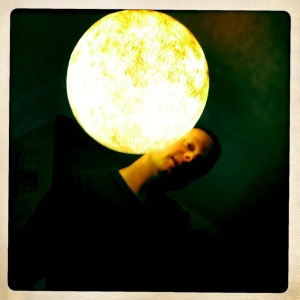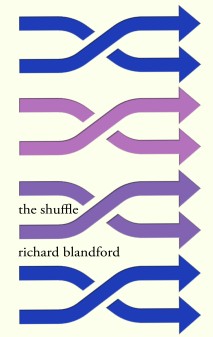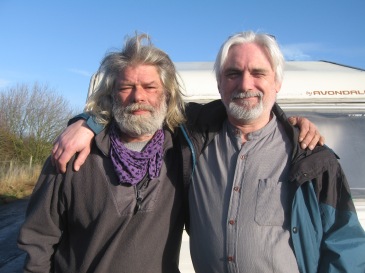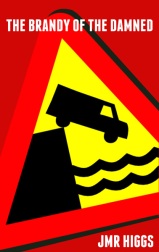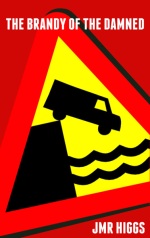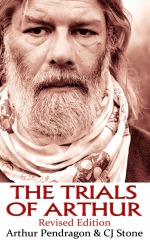Jason Arnopp interviews JMR Higgs
To celebrate publication of The First Church on the Moon, JMR Higgs’ sort-of sequel to The Brandy of the Damned, the author has been interviewed by none other than Jason Arnopp. Jason is the screenwriter of horror movies including Stormhouse and the writer of many Doctor Who, Sarah Jane Adventures and Friday 13th audios and books. None of that impresses us at all. No, the reason we at The Big Hand idolise Arnopp is because he is also the author of The Darkness: Permission to Rock. Yeah! I know!
Here’s the interview:
JA: How would you quickly sum up The First Church on the Moon?
JMRH: The First Church on the Moon is a comedy about the staff of the Steve Moore Moonbase waking up with hangovers, and trying to work out exactly what happened the previous night. Alcohol on the moon is not a good idea, as I’m sure you know. Nor are cats. Or Free Will. It’s basically a novel about things that are not a good idea on the moon, most notably alcohol, cats and free will.
It’s also a concerted effort to imagine a positive future. Most of our current visions of the future are visions of collapse, and I wanted to imagine a future that didn’t shy away from the looming climate and energy problems but which still painted a future that was thriving and where people had a good time.
JA: The First Church on the Moon is much more of a comedy than The Brandy of the Damned. Why the change of tone?
JMRH: Partly for the challenge. Writing a novel that works is hard but writing a novel that works and is also funny is harder still.
Actually, that’s not true. I assumed that would be the case when I started but writing comedy was much easier. It was so much fun to do that I loved every minute of it and it never became a chore. I suspect all those comedy writers who say writing comedy is difficult are basically trying to convince their spouses that they’re deserving of sympathy and respect, even though they’ve just been mucking around all day giggling to themselves.
The other reason is that it is the middle part of a trilogy of three short-ish novels about transformative journeys. The first was The Brandy of the Damned and that was aimed at the head without being rational. This one is aimed at the heart without being sentimental, and the third one will be much more on the sex and death level whilst in no way being gothic or erotic. These are the constraints I set myself at the outset to avoid writing anything predictable or unoriginal. And the way I avoided being sentimental in this one was to be silly. Silliness is a great disinfectant to remove all but the deepest emotions, I think.
Plus it’s an effort to make the wild metaphysical speculations that so plague my books more acceptable, so for all those reasons it was always going to be a comedy.
JA: That third part of the trilogy – is that Phwoar & Peace?
JMRH: It is. Or at least, I hope that is what it will be end up being called, but there’s every chance I may come to my senses and call it something else. But Phwoar & Peace is a step up from some of the titles it has had previously. It was called Michael Once Fucked A Mermaid for a while. That’s really not a good title.
JA: Any idea when that will be released?
JMRH: Not for a while, certainly. I’ll be working on a book about the 20th Century for the rest of the year. I had planned to work on Phwoar & Peace after that, but a couple of other book ideas are shouting at me and for various reasons they need to be done sooner rather than later. So I may put it off for a bit. Plus I’m scared of it. I think it may be genuinely impossible to pull off, or at least it looks that way at the moment. After I had written The KLF and The Brandy of the Damned I seriously thought about not releasing them, as you know, because I thought they might get me sectioned. But this is the only book I’ve been afraid of releasing before it has even been written.
JA: The First Church on the Moon was credited to ‘JMR Higgs’, while the KLF book is coming out as ‘John Higgs’. Is there any logic there?
JMRH: Yeah, almost. ‘JMR Higgs’ is the indie novelist side of me, whereas ‘John Higgs’ is the traditionally published non-fiction author. The KLF and 20th Century will both come out properly on Orion as ‘John Higgs’, like the Timothy Leary biography. Those books are the result of an awful lot of thought, research and work and a great deal of concern for the reader and the bookseller and the publisher has gone into them. They should make sense to the wide world, basically. JMR Higgs books, on the other end, are the product of a dialogue between me and my subconscious and they are under no pressure to please anyone other than me, myself and I. So when they do find themselves chiming with others, that’s a real delight.
I can’t recommend having a foot in both camps enough, its keeps your non-fiction original and your fiction believable. It’s a bit like a band going between tour and studio, tour and studio. Also the subjects of the non-fiction act as a flag to attract people who might be on your wavelength and persuade them that maybe it’s worth risking the fiction.
JA: Will future JMR Higgs books keep the comedy up front?
JMRH: It could go either way at the moment. A lot will depend on the reaction to First Church, I think. Cruel experience tells me that my sense of humour is a bit suspect and something of an outlier, so it depends on whether it reaches enough people with a similarly wrong-headed view of things.
JA: One reference I didn’t understand was the naming of the Moonbase – the Steve Moore Moonbase. Is there a story there?
JMRH: The short answer is that I was reading Somnium by Steve Moore, which is a book about someone in love with the moon that was clearly written by an author who is in love with the moon, so it pleased me to think that there might be a Steve Moore Moonbase one day. The longer answer is that Steve Moore is probably best known for his influence on the considerably more famous Alan Moore, to the extent that he jokes his gravestone will read “Steve Moore – no relation.” But it struck me that the concept of Alan Moore is quite a complex and knotty one. There’s his comic work, his magic work, his influence on culture such as the V for Vendetta mask, his anti-Hollywood stance, his pro-Northampton stance – there’s a lot for future generations to get their heads around. Whereas, the notion that Steve Moore is the bloke who is in love with the moon is immediate and succinct, and as generations pass and memories become stories then stories become legends, I could see that notion being absorbed very easily into the collective unconsciousness. I could imagine that a few centuries from now academics would know all about Alan Moore, but everyone would know Steve Moore because there would be nursery rhymes told about him.
—
The First Church On The Moon is available now ( UK Paperback | UK ebook | US Paperback | US ebook )
The Brandy of the Damned by JMR Higgs and The Beast In The Basement by Jason Arnopp are available together as a AA-sided low-cost ebook.
Jason Arnopp is also author of How To Interview Doctor Who, Ozzy Osbourne And Everybody Else.
KLF: Chaos Magic Music Money
New from The Big Hand – KLF: Chaos Magic Music Money by JMR Higgs. Out now on Kindle.
To celebrate, the artist Shardcore has built a time-limited algorhymically generated Discordian internet radio station called Radio Eris. He explains more here.
The author, meanwhile, has set up a related Tumblr called TheFuckersBurnedTheLot, and talks about the book here.
They were the best-selling singles band in the world. They had awards, credibility, commercial success and creative freedom.
They deleted their records, erased themselves from musical history and burnt their last million pounds in a boathouse on the Isle of Jura.
And they couldn’t say why.
This is the story of The KLF, told through the ideas that drove them. It is a story about Carl Jung, Alan Moore, Robert Anton Wilson, Ken Campbell, Dada, Situationism, Discordianism, magic, chaos, punk, rave and the alchemical symbolism of Doctor Who.
Wildly unauthorised and totally unlike any other music biography, ‘KLF: Chaos Magic Music Money’ is a trawl through chaos on the trail of a beautiful accidental mythology.
“[Higgs] takes us on a switchback ride to the edge of madness, taking in Discordianism, The Illuminatus! Trilogy, Alan Moore, Carl Jung and the number 23 as part of the experience. It’s like he has channelled the spirit of Robert Anton Wilson in the form of a rock biography and invented a new genre along the way.” – CJ Stone, Author of ‘The Trials of Arthur’ and ‘Fierce Dancing’
The Trials of Arthur: Revised Edition is now in paperback
Here’s a Hallowe’en treat for all you paper-fancying ebook-holdouts – the epic revised edition of The Trials of Arthur by CJ Stone and Arthur Pendragon is now available in Paperback – for the same price as the original edition, of course.
You’re welcome!
Here’s co-author CJ Stone on why he returned to and rewrote this wonderful book.
And of course if you think we’re a bit biased calling it a wonderful book, just look at the reviews on Amazon.
Richard Blandford on The Shuffle
So, just what is The Shuffle anyway? A self-shuffling ebook that traps the reader in a never-ending story maze? Can Richard Blandford explain? Let’s fire some questions at the bugger and see if he can justify himself.

THE BIG HAND – What, in your view, is ‘The Shuffle’?
RICHARD BLANDFORD – First of all, The Shuffle is my exciting new ebook of 38 short stories, available for Kindle and priced very reasonably at £2.04. It’s a mix of things – some funny, some not, with the fantastic rubbing up against the banal. A few of the stories are quite long, others are just a paragraph. I personally happen to think it’s jolly good, and am rather proud of it. Thematically , the answer to your question is The Shuffle is a state of mind – the sense of a glut of stuff that cannot be processed, and the surrender to processes outside yourself in order to navigate it. It’s the rejection of desire and the embrace of randomness. It’s liberation and despair at the same time. Needless to say, digital technology has a lot to do with this.
TBG – How important is the format to the overall project? It has been web-based and a shuffling ebook – would it work so well as a physical book?
RB – I would say absolutely that The Shuffle makes the most sense digitally. There is much in there about, to borrow the words of Marx and Engels talking about something entirely different, how all that was solid is now melting into air. Ask any encyclopedia salesperson. It seems right that The Shuffle only exists as pure information, without any physical form of its own. There is a bit in Robert Hughes’s The Shock of the New where he mentions a bronze sculpture of a car in motion, and I think a printed version would be a bit like that. Also, the ebook actually does have a ‘shuffle’ option. It can embody the concept in a way a physical book couldn’t.
TBH – Why did you move from writing novels to writing short stories?
RB – I can’t really remember because the first short story dates from about 2006, but I might have read somewhere that writing them was a good thing for a writer’s career. Turns out this bit of advice was somewhat past its use-by date.

TBH – What’s your favourite story in the collection?
RB – This is a difficult one. It shifts over time. Unarguably the ‘best’ story is The Man Who Drew the Brook, about an artist repeatedly drawing the same scene. It’s the one people seem to have latched on to, and the one that most closely resembles what a short story is classically meant to be like. But I’m personally more drawn to the crazier ones at the moment, such as Table For One at the Unfolding Lotus, where a man attends a strange restaurant in the hope of being let in on a fantastic secret. It was inspired by me watching an episode of Doctors that was so ineptly written, what I thought was going on was completely different to the actual intended story. I decided my version was more interesting. Also, The Exiles of Selousia, about the former inhabitants of a country that no longer exists, continues to tickle my fancy. It’s not the sort of thing I’d expect myself to write, so I’m perpetually surprised to find that I did.
TBH – Is there an overarching theme to the collection?
RB – There are various themes, all shuffled together, but they intersect at points throughout. Firstly there’s what I mentioned earlier about the dissolving of the physical in the digital, but perhaps the overriding theme is the idea that we don’t really know anybody. We create models of people in our heads from our experience of them, but that model is not them. It’s argued that supernatural experiences and the feeling of knowing God are something to do with this process, and there are various stories to do with that. I question what makes up a person anyway, whether they have any sort of essential essence or soul, and there are speculations about any possible afterlife. Then there’s the question of how we experience others through the net and the like – how has that changed how we ‘know’ people? A fair bit about surrender and resistance, to both people and processes. There’s a lot to do with processes. Quite a bit of systematic, obsessive behaviour in The Shuffle. Being autistic myself I find that sort of thing especially interesting.
TBH – Do all these come from one short burst of writing or were they built up over time?
RB – For the most part, they were all written over a period of two years. I would say there was a period of my writing that I very much see as The Shuffle Era, and when the stories I was writing no longer seemed to fit with the work as a whole, I declared it finished.
TBH – In this new ebook era, do you think short story collections are becoming more popular? And if so is that because writers have been liberated from publisher’s demands for certain lengths, or because readers have shorter attention spans?
RB – I’m not sure. Maybe. I haven’t looked at the figures. I don’t know if they will become appreciably more popular, because the main reason people stay away from them – that they don’t like having to get their heads around a bunch of new characters every 20 pages or so – still stands. But it will provide an opportunity for people writing them to get them to people who want them. I can certainly see the novella getting a new lease of life.
TBH – What are you working on now?
RB – I’ve got two manuscripts that I have declared finished or near finished at various points over the years, but I want to rewrite both of them from scratch. I don’t know when that will happen though, because I’m helping bring up my one year-old daughter right now!
TBH – Snog, Marry, Kill: Amazon, Google, Apple?
RB – Snog: Google, because they genuinely are very good at what they do. There’s a few bad things about them like the tax avoidance and the time they made all those Chinese seven year-olds power that steampunk spaceship by having them all walk in a giant hamster wheel, but no one’s perfect.
Marry: Amazon. Realistically, an author like myself who has been spat out of the regular publishing industry due to the ‘two-strikes-and-you’re-out’ rule is going to mostly rely on Amazon just to get their work out there. But it would be a joyless marriage in which I constantly nag them about their negative effect on small independent bookshops.
Kill: Apple. When I got my first Mac a while back after having a PC for years it was like travelling into the future. Now I’ve gone back to a PC because they’re cheaper, and everything that was great about Macs has been absorbed. Apple pissed me off with their constant updates that push your hardware into obsolescence. In fact, they are dead to me already.
—
CJ Stone: Why I (re)wrote The Trials Of Arthur
I wrote the original version of The Trials of Arthur between 2000 and 2003.
It was a book I’d wanted to write for a long time.
I’d originally come across Arthur Pendragon in the mid-nineties, through my good friend Steve Andrews, while I was working on my first book, Fierce Dancing.
There was something about the story which caught my imagination.
Just to give you a brief outline: Arthur Pendragon is this ex-soldier, ex-builder, ex-biker who had some sort of a brain storm back in 1986 and decided he was King Arthur. When I heard about him he was already moderately famous, not only as a media figure – he had been on the Clive Anderson show and had had a number of radio and TV documentaries made about him – but he was also central to the campaign for open access to Stonehenge and heavily involved in the road protest scene of the time. By the time I met him, late in 1996, he was living on-site at the Newbury bypass, then the most prominent and fiercely contested of the road building schemes.
Fierce Dancing had featured a road protest and I had already acquired the status of a sort of spokesman for the movement through my columns in the Guardian and the Big Issue.
It was more than just a protest scene. There was something profound and archaic at its heart. It seemed to evoke feelings and ideas that came from a very deep place. It was tribal. It was animistic. It was archetypal. Arthur’s story seemed to fit in well with the general ethos. I spent the better part of 1996 chasing all over the UK looking for him.
I finally met him in August of that year, at Avebury stone circle in Wiltshire, where we both got very drunk, after which, still drunk, I drove him and another bunch of drunken people over to Bath, where we got even drunker.
That was something Arthur and I did a lot of in our early days.
At the time my writing style was very tongue-in-cheek, and Arthur seemed a very tongue-in-cheek kind of hero. He often referred to himself as “the nutter who thinks he’s King Arthur”, which tells you a lot about Arthur’s approach to his identity. Had I written the book then it would almost certainly have been a comedy. I would have played it for laughs. It still is a comedy to a large extent, meaning that there are a lot of funny bits in the book. But it also has a serious point, something I’m not sure I would have been so clear about back in 1996.
So, then, the book didn’t get written in 1996. Other things got in the way. And by 2000, when I finally got round to starting work on it, my life had taken an uncomfortable turn. I was no longer a Guardian writer, and I was no longer writing for Faber & Faber either. The book was commissioned by Thorsons/Element, a New Age imprint of Harper Collins. I felt I was going down in the world. And it wasn’t me who got the commission, it was Arthur. So I was going to have to accept joint authorship, and I no longer had complete control over the end product. This was difficult. I was writing to please Arthur, not writing to please myself, which had a detrimental effect upon my style. I was never anywhere near as confident writing this book as I had been with the others.
Arthur’s view of himself is conditioned by his own self-mythologizing, of course. This is something we all do, but it is greatly compounded when you are not only self-mythologizing in the normal way but also identifying yourself with a mythological hero who is attempting to bring the mythology up to date. This is like mythologizing cubed. Mythology times mythology times mythology.
Arthur thinks he’s Arthur because he always has been Arthur. But clearly there had been a life before this which I insisted on exploring. As I said at the time, it will make the book all the more believable if we know where Arthur comes from. This tends to give the book a kind of hagiographical quality at first as in Arthur’s mind he was always destined to be Arthur. This is one of the prime weaknesses of the original book. Arthur emerges as a hero because of some sort of inherent quality he was born with, rather than as someone who stepped up to the mark and took on the role, which I now think is much nearer the truth. It’s not that Arthur is Arthur because he always was Arthur. It’s that he’s Arthur because he’s made himself Arthur. He’s worked at the role and made it come true. He’s evoked the name and taken the consequences. He adopted the name without necessarily knowing what it would involve. But then the name turned round and bit him and he’s never really been the same since.
So I was never very happy with the first part of the book. It was too much “Arthur did this” and “Arthur did that” and “good old Arthur”, without looking into the context or paying very much attention to anyone else.
Later I started writing about the protest movement, and this is when the original book starts to get really good. In that version of the book, it takes off around the half-way mark, and in the rewrite I’ve virtually done nothing to change the second half. It was always very good and it still is very good.
The book came out in 2003 and then quietly died a death. By 2009 it was out of print, and Arthur had managed to get the rights back. That’s when he approached me and asked if I could get the book back into print.
Thus it was that in early 2010 I started rewriting the book.
The first thing I did was to get rid of the introduction, which I had never liked. It was slow and clumsy and introduced you to characters that later were to play very little part in the book. It rambles all over the place while never locating you anywhere in particular. Later in the book I had made a decision that whenever a place is evoked we would really enter that place. We would step across its threshold and visualise it. If anyone reading this is ever planning to write a book, I would suggest this as good advice. Be there. Make it live. Make the pages come to life. This is very much what I failed to do in the original introduction.
So the new first chapter takes you right into the heart of an adventure: on the Prescelly Mountains in Pembrokeshire, at Halloween in 1994. We are introduced to people as archetypes. It’s not only Arthur as an archetype, but everyone else as an archetype too. This is a much more satisfying way of entering the book. Arthur is seen as one of many, not one on his own, and his story seems all the more profound for that. It is the story of a whole culture.
We also bring in another innovation: the story of the pagan calendar which runs like a thread throughout the book. Each of the pagan festivals is invoked, starting with Samhain, and ending with the Autumn equinox. This is absolutely precise, as Samhain represents the pagan New Year.
The book still has Arthur at its heart, of course, but it is also much more about the people around him too. It’s about people remaking themselves, just as Arthur remade himself. It is about the making of a culture as much as the making of a man.
The new book has 24 chapters whereas the old book had 17. This makes a difference of seven chapters. But two of the old chapters have been jettisoned, so in fact there are nine brand new chapters in this book. Two of them were written by Arthur, and the rest by myself. You’ll be able to tell the difference. Arthur’s chapters are very much more tongue-in-cheek than mine, meaning that he’s continued the book I might have written in 1996 and proved to me that he still is a tongue-in-cheek hero.
As for its relevance: it is not about contemporary events, but about things which happened back in the 90s. However, it is about protest, and there are even more things to protest about now than there ever were. The book is virtually a handbook for successful protest. We could subtitle it: How To Protest And Stay Sane!
It is also about challenging the mores of the dominant culture. It is about forging a new identity, about seeking something authentic in a world of dross, about finding something real in a world conditioned by advertising slogans. In other words, it is more deeply relevant now than it ever was.
At our first meeting with the publishers back in 2000 I had asked Arthur what he wanted the message of the book to be.
“If I can do it, anyone can!” he said.
Which doesn’t mean you have to wear a dress and a crown to emulate him. It just means you have to be authentically yourself.
The Trials of Arthur – now on Kindle
Yep, The Trials of Arthur by Arthur Pendragon by CJ Stone is now available on Kindle priced £2.05, and just in time for the Solstice too. 
But it’s not the Trials of Arthur that you may already know. This is a new, revised version containing seven new chapters from both authors and much that is rejigged, reworked and generally loved up. To give you a sense of how much revision there has been, the new version is over 20,000 words longer than the original.
All this raises the question of whether it is worth spending £2.05 for people who have already read the paperback. And to be honest, it is – this wasn’t the original intention, you understand, originally we were only going to tweak a few bits for the Kindle. But something possessed the authors and they got carried away, to the point that they are now ecstatically happy and convinced that the book is “everything it could possibly be.”
The Trials of Arthur was already an extraordinary book – a biography that is equal parts heroic and mad as all hell, a deep insight into what it means to be alive, and the definitive book about the protest scene of the late twentieth century. Anyone not already familiar with the story is strongly advised to at least have a glance at the free sample.
We’ll get Arthur or Chris on here soon to explain themselves soon but if you want to quiz them sooner, you’ll find them at Stonehenge by the Heel Stone for the Solstice. Happy Midsummer!
JMR Higgs speaks to Flinton Chalk
Here at The Big Hand we’ve been delighted by the reaction to The Brandy of the Damned, the debut novel from JMR Higgs. Here Flinton Chalk from the band TC Lethbridge emerges from his decades-long slumber to speak to the author:
FC: As I understand it, you’re won’t talk about what The Brandy of the Damned means, is that right?
JMRH: More or less, yeah. I made a promise to one of the first people who read it that I would never explain it, to him or to anyone. I think he feared that the explanation in my head would be a great disappointment compared to whatever interpretation he had in his head. So, other than to reassure you that the whole thing makes perfect sense, I try not to be too specific. I can talk around it, of course. I can talk around it like a good ‘un.
FC: One review I read said that it “was to middle age what Gregory’s Girl was to the teenage years.” Would you agree with that?
JMRH: Yeah that sounds good, doesn’t it? I can’t actually remember much about Gregory’s Girl but I think it’s a compliment. As for the middle age bit though – as I see it, for the first half of our lives we’re driven by a yearning for euphoria and in the second half of our lives we’re driven by a yearning for Grace. Which is a good system, I think, I think we’re lucky it works like that. But the switchover point is not an easy one to navigate, and that’s roughly where the characters are in their lives, so I can understand it for that reason.
But that said – if you were to set a novel in the very heart of Britain, you would have done that in order to talk about Britain in its entirety. The centre point is a good place to get perspective in all directions.
FC: Another reader called it “dense like a fruit cake.”
JMRH: Yeah! But that’s what books are supposed to be, aren’t they? Or at least, it’s how they’re going. Readers deserve twice as many ideas told in half as many words, I think. Especially in non-fiction, where there are all these ‘one idea’ books that would have made brilliant essays, but which have been strung out to whatever length it is that conforms to the publisher’s prejudices. So one good thing about the ebook revolution is that maybe we’ll get past all that legacy baggage and treat the reader a bit better.
I’m slightly wary that some reviews make the book sound hard going or difficult, though. It’s a really easy, light, good-humoured read. It’s only afterwards, when people start to write reviews, that they get bogged down with all the stuff that it’s dredged up for them.
FC: Is it easy to market such a book like that? It’s not part of any obvious tradition.
JMRH: No, it’s totally impossible. It’s a debut non-genre novel from an unknown writer, there’s no hope for it. But that said, there is always word of mouth. And a good way to get word of mouth is to write something that plays bloody hell with the reader’s subconscious, to the extent that they gibber about it afterwards with anyone they meet in order to get their head stable again. That’s pretty much the only option available to me.
I dread to think what damage my next one will do, that goes much further along that road (ED: this is a book that’s not been announced yet, but which will be out in September.) (UPDATE: Let’s say January). Reading The Brandy of the Damned seems to make a really positive difference to people, but the next one might undo all that good work, I fear.
But it’s a good time to do this because publishing is in such a weird state. It’s never been easier to get published and so everyone is getting published, which is great. But oddly, they are all publishing books that don’t need to be published. They are all writing books about vampire cops or some shit. Because that’s what the logic of the industry demands, you know, books which are the same as books that have already been written.
It’s no different to music or films or whatever. They’ve just made a $200 million film about the Battleships board game, not because anyone involved thought it was a good idea but because everyone involved understood that the logic of the industry dictated that the film would actually get made and they’d get paid. So as long as you completely ignore the prevailing wisdom of the industry, it’s actually a great time to write something like The Brandy of the Damned, something that I think comes from a deeper place but without falling into the moon-eyed, sentimental new-agey thing, because no other fucker seems to be doing that at the moment.
FC: But if they were, would you know about it?
JMRH: No, you’re right, that’s where the whole theory falls down. I suspect most of the potential readers for stuff like this don’t have time to read it because they are too busy going on the Internet to complain about the Battleships movie.
I take the view, though, that I’m extraordinarily lucky because I have such a remarkable readership. I mean, they’re great, my readers, they are qualitatively better than other writers’ readers. They just rock, basically, there’s research out there that claims that one of my readers is worth 50 normal readers. Why this is, I have no idea, but I’m not complaining!
As I understand it, all literary conferences next year are devoting sessions to debating the phenomenon, with an eye to reacting to it sometime in 2017.
FC: That’s not true, is it?
JMRH: No, not at the moment. But if you put it in the interview, and people read it and repeat it, it’ll become a little bit more established and that is almost as good as truth. On a practical level, I mean.
—
The Brandy of the Damned is out now on Kindle at the ridiculous price of £1.64 or somesuch, and will be available in paperback at a more sensible price in the near future. The author can be found over on his blog and on Twitter. Flinton Chalk may or may not appear online soon, you can never tell.
Two New Books From JMR Higgs
Much excitement here at The Big Hand as we prepare to publish not one but two books by JMR Higgs this year. You may know Higgs as the author of I Have America Surrounded: The Life of Timothy Leary, or maybe from the interview he did for us with CJ Stone.
 First up is The Brandy of the Damned, his short debut novel and a strange jewel of a book. It’s the story of three members of a band who, twenty years after they broke up, meet again to embark on a quest to drive around the coast road of Britain – in order to see where the coast road goes. It’s balls-out confident, unpredicable and a completely original book that plays with notions of fate and our relationship with time in a winningly good humoured and largely absurd manner.
First up is The Brandy of the Damned, his short debut novel and a strange jewel of a book. It’s the story of three members of a band who, twenty years after they broke up, meet again to embark on a quest to drive around the coast road of Britain – in order to see where the coast road goes. It’s balls-out confident, unpredicable and a completely original book that plays with notions of fate and our relationship with time in a winningly good humoured and largely absurd manner.
We think it will delight you.
The Brandy of the Damnedwill be published in paperback in September but, for those of you who need summer reading on your Kindle, the ebook is available right now, DRM-free, from Amazon. Best of all, it has the low price of £1.64, and it will stay that price until the paperback is released.
Also in September comes his next book – which we are keeping close to our chest at the moment, save to say that it is a non-fiction title. We’ll announce the subject in due course, but until then if we tell you that the ground the book covers includes Carl Jung, Alan Moore, Robert Anton Wilson and Doctor Who, then perhaps you can work out what it is about?

